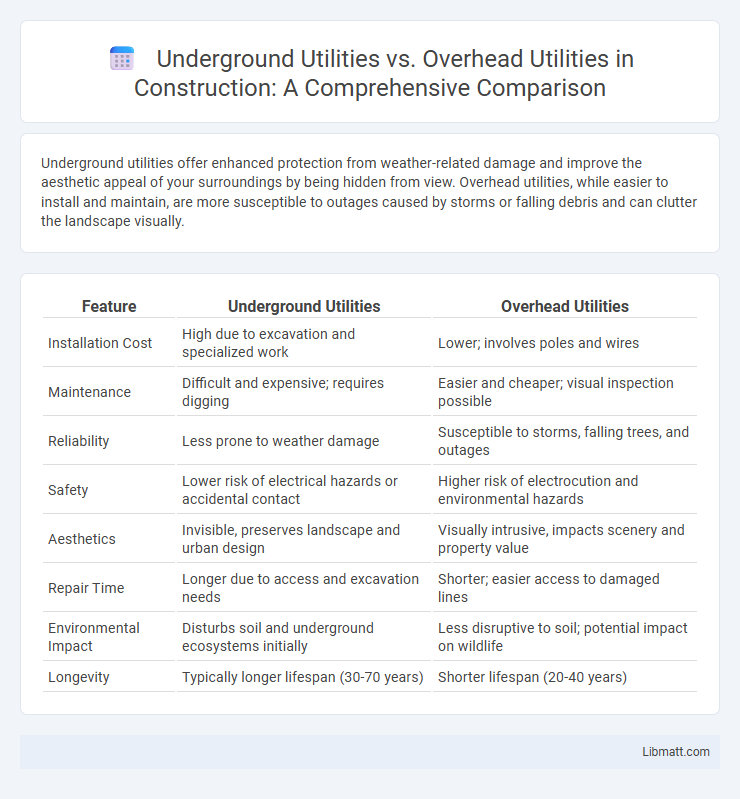Underground utilities offer enhanced protection from weather-related damage and improve the aesthetic appeal of your surroundings by being hidden from view. Overhead utilities, while easier to install and maintain, are more susceptible to outages caused by storms or falling debris and can clutter the landscape visually.
Table of Comparison
| Feature | Underground Utilities | Overhead Utilities |
|---|---|---|
| Installation Cost | High due to excavation and specialized work | Lower; involves poles and wires |
| Maintenance | Difficult and expensive; requires digging | Easier and cheaper; visual inspection possible |
| Reliability | Less prone to weather damage | Susceptible to storms, falling trees, and outages |
| Safety | Lower risk of electrical hazards or accidental contact | Higher risk of electrocution and environmental hazards |
| Aesthetics | Invisible, preserves landscape and urban design | Visually intrusive, impacts scenery and property value |
| Repair Time | Longer due to access and excavation needs | Shorter; easier access to damaged lines |
| Environmental Impact | Disturbs soil and underground ecosystems initially | Less disruptive to soil; potential impact on wildlife |
| Longevity | Typically longer lifespan (30-70 years) | Shorter lifespan (20-40 years) |
Introduction to Underground and Overhead Utilities
Underground utilities, including water, gas, and electrical lines, are installed below the surface to enhance aesthetics and reduce weather-related damage, while overhead utilities, such as power and communication lines, are suspended above ground for easier access and maintenance. Underground systems offer greater protection from storms and physical interference but require higher installation and repair costs compared to overhead lines. Overhead utilities, although more vulnerable to environmental factors, provide quicker fault detection and lower initial investment, making their use prevalent in many urban and rural settings.
Key Differences Between Underground and Overhead Utilities
Underground utilities are installed below the surface, protected from weather and physical damage, resulting in fewer outages and enhanced aesthetic appeal compared to overhead utilities, which are mounted on poles and exposed to environmental elements. You benefit from lower maintenance costs and reduced risk of service interruption with underground systems, while overhead utilities allow easier access for repairs and upgrades, often at a lower initial installation cost. Understanding these key differences helps in planning infrastructure that balances durability, cost, and service reliability.
Installation Processes: Underground vs Overhead
Underground utility installation involves trenching, conduit placement, and cable pulling, requiring heavy machinery and careful soil restoration to protect lines from damage. Overhead utility installation includes erecting poles, stringing cables, and securing hardware, often completed faster but exposed to environmental hazards like storms and wind. Your choice affects maintenance complexity, installation duration, and long-term reliability of power or communication services.
Cost Comparison: Underground and Overhead Utilities
Underground utilities generally involve higher initial installation costs due to excavation, materials, and specialized labor, often exceeding overhead utility installation expenses by 2 to 5 times. Overhead utilities offer lower upfront costs and easier maintenance but are more susceptible to weather-related damage, potentially increasing long-term repair expenses. Evaluating your project's budget and environmental risks can help determine the most cost-effective utility placement option.
Reliability and Performance Factors
Underground utilities offer enhanced reliability by being less susceptible to weather-related disruptions such as storms, high winds, and ice accumulation, which commonly affect overhead lines. Performance factors favor underground systems through reduced maintenance requirements and lower outage rates, contributing to consistent service delivery and increased system lifespan. However, underground utilities can face challenges from soil conditions and excavation activities, which may impact repair times and costs.
Safety Considerations for Each Method
Underground utilities reduce the risk of outages caused by weather events and minimize accidental contact, enhancing overall public safety. Overhead utilities, while easier to inspect and repair, pose higher risks of electrocution, falling lines, and vehicle collisions. Proper insulation, clear marking, and maintenance protocols are critical to ensuring safety in both utility methods.
Environmental Impact and Aesthetics
Underground utilities significantly reduce environmental impact by minimizing habitat disruption, lowering risks of accidental damage, and preventing visual pollution. Overhead utilities are more susceptible to weather-related issues and can disrupt natural landscapes, detracting from your property's aesthetic appeal. Choosing underground utilities enhances environmental sustainability while preserving a clean, unobstructed visual environment.
Maintenance and Accessibility Challenges
Underground utilities face complex maintenance challenges due to limited accessibility, requiring excavation and specialized equipment to identify and repair faults, which increases repair time and costs. Overhead utilities offer easier access for routine inspections and repairs, minimizing downtime but are more vulnerable to weather-related damage such as storms and high winds. The balance between underground durability and overhead convenience impacts utility management strategies in urban and rural infrastructure planning.
Urban Planning and Community Preferences
Underground utilities enhance urban planning by reducing visual clutter and increasing land use flexibility, which aligns with community preferences for aesthetically pleasing and safer environments. Underground systems are less vulnerable to weather-related disruptions, supporting more reliable service and improved public safety. Your urban projects benefit from higher property values and community satisfaction when utilities are placed underground.
Future Trends in Utility Infrastructure
Advancements in underground utilities are driving future trends in utility infrastructure due to their increased reliability, reduced maintenance costs, and minimal visual impact compared to overhead utilities. Smart grid technologies and Internet of Things (IoT) integration are more easily implemented in underground systems, boosting operational efficiency and outage management. Companies are investing heavily in underground utility installations to future-proof your infrastructure against extreme weather events and urbanization demands.
Underground utilities vs overhead utilities Infographic

 libmatt.com
libmatt.com